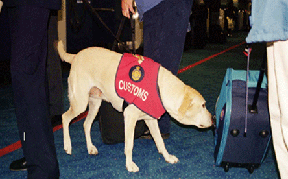RIGH DOG - RIGHT JOB - RIGHT HANDLER
Good choices can save an agency time, money, and grief. (BY KEN PAVLICK)
Visualize a patrol dog spinning uncontrollably in the back of a marked K-9 unit, or a detection dog dragging his handler across a parking lot toward a search venue. We've all seen such events. Everyone wants a high drive dog, but is a truly high drive dog the best dog for all handlers, in all situations? Generally speaking, the answer is no. A very intense, fast dog, placed in the wrong environment with the wrong person, can be a ricepe for disaster. On the flip side, how often has a departement that has a high volume of calls crushed the spirit of a more methodical dog with overwork? With some forethought and prior planning, the right dog, placed with the right handler, in the right circumstances, can help ensure success.
Selection Testing
Evertone wants to select the best dog for themselves, their unit, and their agency. In the five years since I left full time law enforcement K9 work to become a vendor, I have seen some interesting things when it comes to dog selection. I have watched people test 10 to 14 dogs in order to select four. And after I watching their selection testing - testing process, I have had no idea why they chose those particular dogs. I also have observed people test dogs knowing exactly what they are looking for and how to test for it and leave with the first dog they pulled out of the kennel. The difference? I believe the second group had a clear-cut idea of what they were looking for in a detection dog candidate, his role, and his purpose. Therefore, they knew immediately when they saw the right dog. The first group was looking for all round generic detector dogs. And without a specific type of the dog beyond the generic term "high drive", they spent more time than was required.
Consider the type of work
Because I deal mostly with single purpose detector dogs, this article will focus on those. However, I believe the thoughts expressed here also have validity for dual purpose or cross trained dogs.
Explosives detection, narcotics detection, and humans remains detection all require detector dogs, but slightly different selection criteria should be applied to each. Sure, we all want the perfect dog, able to do any and every task. Those dog are out there. But they are getting harder to find, and their value (cost) is increasing rapidly. Identifying and selecting for the most desirable characteristics can enable you to find the most suitable and potentially successful candidate - quite possibly one you might have over looked in the past.
Consider the Handler
Pairing the right handler with the right dog is crucial. Now I am not naive enough to believe that every dog handler is perfectly suited to the job. Sometimes politics enter into the selection process and the unit supervisor or trainer is left with a less than perfect prospective handler. Matching the handler with a dog that best suits his or her personality can allow you to have a successful, high-performing canine team.
For example, an overweight, out-of-shape, or older handler might not pair well with an intense, fast moving, purely instinctual animal. That type of dog probably is better suited to a young, motivated handler. Likewise a small, methodical, slow-searching dog could pair well with a slower-paced, more detail-oriented handler.
Ofcourse, I am speaking in generalities here and, just as in the rest of life, there are more exceptions than rules. But taking the extra time to assess your human component as carefully as you assess the canine half will go a long way to ensuring future success.
Consider the Work Environment
Lately, it seems as though everone wants the perfect-looking Labrador Retriever with the big, blocky head, or the stereotypical Golden Retriever with the long, flowing, deep red coat. As a vendor, I can place a good looking dog that has good drives much faster than I can place unique-looking dog that has superior drives. I am not sure whether that is due to prejudice, public perception, or tradition. But choosing a dog whose physical characteristics fit a specific work environment can go a long way toward enhancing the canine team's success and effectiveness.
|



